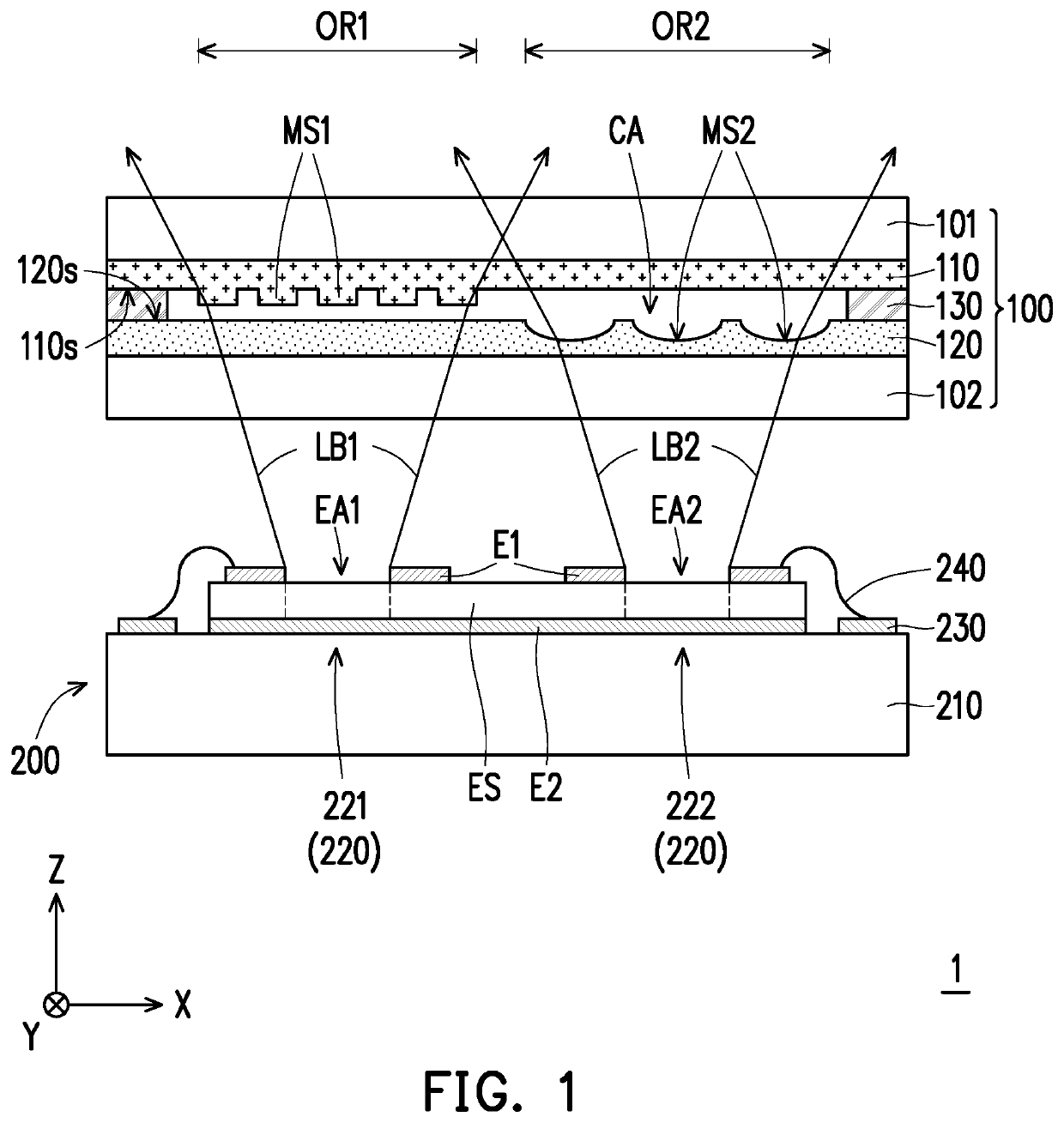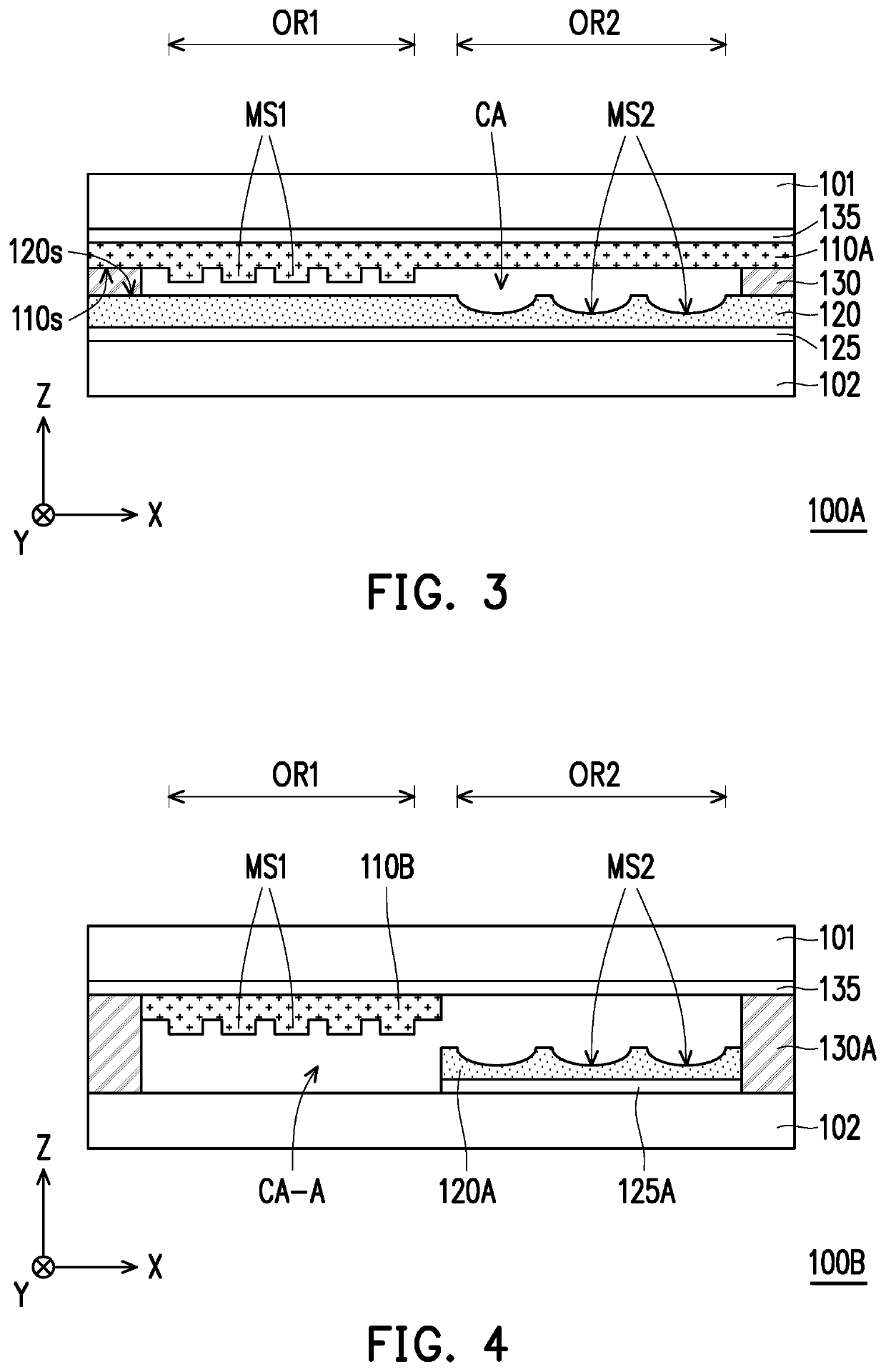Optical element and wafer level optical module
a technology of optical elements and wafers, applied in the field of optical elements and can solve the problems of difficult miniaturization of wlo modules, and achieve the effect of improving the integration degree of wafer level optical modules and more optical functionality
- Summary
- Abstract
- Description
- Claims
- Application Information
AI Technical Summary
Benefits of technology
Problems solved by technology
Method used
Image
Examples
first embodiment
[0039]FIG. 1 is a schematic cross-sectional view of a wafer level optical module according to the invention. FIG. 2 is a schematic top view of the wafer level optical module in FIG. 1. In particular, for clear presentation and explanation, FIG. 2 omits the illustration of spacer 130, first electrode E1, second electrode E2, epitaxial structure ES, circuit substrate 210, pad 230 and bonding wire 240 of FIG. 1.
[0040]Referring to FIG. 1 and FIG. 2, a wafer level optical module includes an optical element 100 and a light emitter 200. The optical element 100 is arranged on the optical path of the light emitter 200. Specifically, the light emitter 200 has a plurality of light exiting apertures, for example, a light exiting aperture EA1 and a light exiting aperture EA2. The optical element 100 is overlapped with these light exiting apertures. For example, in the present embodiment, the optical element 100 has a first optical region OR1 and a second optical region OR2. It should be noted th...
second embodiment
[0054]FIG. 3 is a schematic cross-sectional view of an optical element according to the invention.
[0055]Referring to FIG. 3, the difference between the optical element 100A of the present embodiment and the optical element 100 of FIG. 1 lies in the composition of the optical element. In the present embodiment, the optical element 100A further includes an index matching layer 135 and a buffer layer 125. The index matching layer 135 is disposed between the first substrate 101 and the first optical film 110A. The buffer layer 125 is disposed between the second substrate 102 and the second optical film 120. Due to the refractive index of the first optical film 110A is high (for example, the refractive index is greater than 1.7), the reflection of the light beam at the interface between the first substrate 101 and the first optical film 110A can be inhibited by configuring the index matching layer 135. In the present embodiment, the width of the first optical microstructure MS1 or the pi...
third embodiment
[0057]FIG. 4 is a schematic cross-sectional view of an optical element according to the invention.
[0058]Referring to FIG. 4, the difference between the optical element 100B of the present embodiment and the optical element 100A of FIG. 3 lies in the configuration of the optical element. In the present embodiment, the spacer 130A is connected between the index matching layer 135 and the second substrate 102. The index matching layer 135, the second substrate 102 and the spacer 130A define a cavity CA-A of the optical element 100B. The first optical film 110B, the second optical film 120A and the buffer layer 125A are disposed in the cavity CA-A.
[0059]Particularly, the orthogonal projection of the first optical film 110B on the first substrate 101 does not overlap with the orthogonal projection of the second optical film 120A on the first substrate 101. For example, compared to the optical element 100A of FIG. 3, the manufacturing process of the optical element 100B may further includ...
PUM
| Property | Measurement | Unit |
|---|---|---|
| width | aaaaa | aaaaa |
| width | aaaaa | aaaaa |
| width | aaaaa | aaaaa |
Abstract
Description
Claims
Application Information
 Login to View More
Login to View More - R&D
- Intellectual Property
- Life Sciences
- Materials
- Tech Scout
- Unparalleled Data Quality
- Higher Quality Content
- 60% Fewer Hallucinations
Browse by: Latest US Patents, China's latest patents, Technical Efficacy Thesaurus, Application Domain, Technology Topic, Popular Technical Reports.
© 2025 PatSnap. All rights reserved.Legal|Privacy policy|Modern Slavery Act Transparency Statement|Sitemap|About US| Contact US: help@patsnap.com



